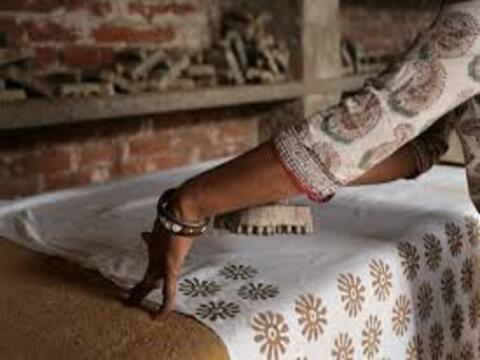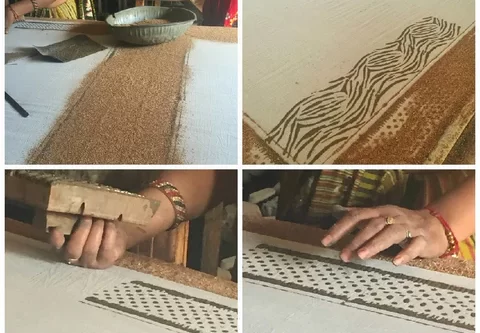Hastchhap Presents How To Do Hand Block Printed Mud Dabu Printing
The technique involves using a mixture of mud and other natural materials to create a resist pattern on the fabric, which is then dyed in indigo or or other natural dyes. Hand Block Printed Mud Dabu Print Fabric has become famous all over the world. The mud mixture is applied to the fabric using a wooden block, which has the desired pattern carved on it. And block printing using the mud-resist Dabu technique is a fascinating and intricate process deeply rooted in the traditional textile heritage of India. This artisanal method involves a series of steps that require skill, precision, and patience.
Rajasthan is acknowledged as the most prolific state for hand-block printing in India. According to ancient times, the origin of this art was found in China. Within a long time, hand block print extended in India and today villages of (Sanganer, Bagru, and Angola) Rajasthan have become the most prominent producers of various hand block prints. Dabu print was produced about 675 A.D in the village of Akola, Chittorgarh district. The way of making hand block printed Mud Dabu print fabric is known as “Dabanna” which means “press”. To keep the Families in Akola continue to make this fabric to preserve their traditional heritage.
Because of the prevalent alternatives, the art died before independence, but it began to resurface in the twenty-first century. Families in Akola continue to make this fabric to preserve their traditional heritage. Because of the prevalent alternatives, the art died before independence, but it began to resurface in the twenty-first century.

Preparation of Fabric –
The process commences with preparing the hand block printed Mud Dabu print fabric cotton fabric to be printed. The fabric is washed thoroughly to remove any impurities and ensure the surface is clean and ready for the dyeing and printing processes.

Mud-Resist Paste Preparation –
The core element of the Dabu technique is the mud-resist paste. This paste is made using a unique blend of natural materials, including clay, gum Arabic, wheat chaff, and other binding agents. This special mixture forms a paste that acts as a resist against the dye, preventing it from penetrating the fabric in specific areas, creating the desired patterns.
Wooden Block Carving –
Artisans carve intricate designs onto wooden blocks that serve as stamps for the printing process. These blocks are meticulously crafted, with each pattern intricately detailed and unique. The design on the block determines the final pattern that will be imprinted on the fabric.
Printing Process –
The mud-resist paste is then skillfully applied to the fabric using these intricately carved wooden blocks. The craftsman dips the block into the paste and stamps the fabric, ensuring an even distribution of the mud-resist mixture across the cloth. The process is repeated meticulously to create the desired pattern across the fabric.

Sun-Drying and Setting –
Once the printing is completed, the fabric is left to dry in the sun. The sun-drying process aids in setting the mud-resist paste into the fabric and helps the cloth to retain the resist effect. This crucial step ensures that the dye won’t seep into the areas covered by the mud-resist paste during the dyeing process.
Dyeing with Natural Colors –
The next phase involves dyeing the fabric using natural dyes obtained from plants, minerals, and other organic sources. The fabric is submerged in large vats of natural dye, allowing the colors to seep into the portions of the cloth not covered by the mud-resist paste. This step is often repeated multiple times to achieve the desired depth and richness of color.

Washing and Removal of Mud Resist –
Following the dyeing process, the fabric undergoes thorough washing to remove the mud-resist paste. This reveals the beautiful, intricate patterns and designs created by the contrast between the dyed and undyed areas of the fabric.
Final Treatment and Finishing –
To ensure the longevity of the print and to soften the fabric, a final treatment is often applied. This could involve additional washing, fixing agents, or other treatments to set the colors and prepare the fabric for its eventual use.
Conclusion –
The hand block printed Mud Dabu print fabric technique is a labor-intensive and intricate process that produces stunning and unique fabric with distinctive patterns and a rich cultural heritage. Each piece of Dabu-printed fabric is a testament to the artistry, patience, and skill of the craftsmen who have upheld this traditional method for generations.



